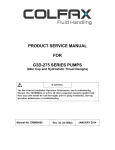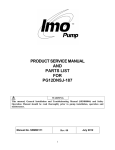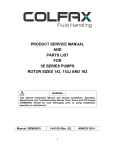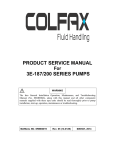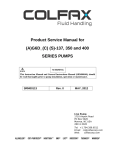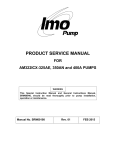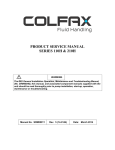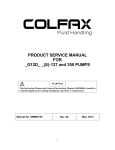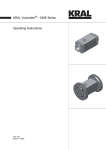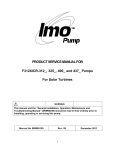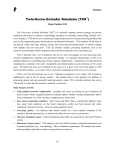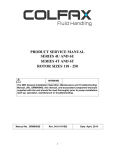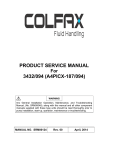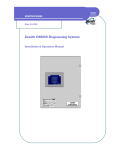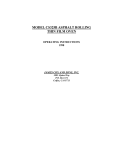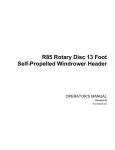Download PRODUCT SERVICE MANUAL For BK12DXZC
Transcript
PRODUCT SERVICE MANUAL For BK12DXZC-250P PUMP BM# 3215/572 WARNING This manual, General Installation and Troubleshooting Manual (SRM00046) should be read thoroughly prior to pump installation, operation and maintenance. Manual No. SRM00120 Rev 00 JULY 2013 Imo Pump 1710 Airport Road PO Box 5020 Monroe, NC USA 28111.5020 Tel: +1.704.289.6511 Email: [email protected] Web: colfaxcorp.com 1 READ ENTIRE PAGE BEFORE PROCEEDING FOR THE SAFETY OF PERSONNEL AND TO PREVENT DAMAGE TO EQUIPMENT, THE FOLLOWING NOMENCLATURE HAS BEEN USED IN THIS MANUAL: DANGER Failure to observe precautions noted in this box can result in severe bodily injury or loss of life. WARNING Failure to observe precautions noted in this box can cause injury to personnel by accidental contact with equipment or liquids. Protection should be provided by user to prevent accidental contact. CAUTION ATTENTION Failure to observe precautions noted in this box can cause damage or failure of equipment. Non compliance of safety Safety instructions where instructions identified by electrical safety is the following symbol involved are identified by: could affect safety for persons: Safety instructions which shall be considered for reasons of safe operation of the pump and/or protection of the pump itself are marked by the sign: ATTENTION CONTENTS SAFETY AND TABLE OF CONTENTS ................................................................... ..2 A. GENERAL INSTRUCTIONS ............................................................................ 3 B. INTRODUCTION .............................................................................................. 3 C. DESCRIPTION OF THE PUMP ........................................................................ 3 D. PUMP MODEL IDENTIFICATION .................................................................... 4 E. ORDERING INSTRUCTIONS .......................................................................... 4 F. OPERATION ................................................................................................... 4 G. PARTS LIST .................................................................................................... 5 H. PUMP MAINTENANCE (Disassembly and Assembly)....................................... 6 I. SPECIAL TESTING INSTRUCTIONS ............................................................... 11 J. TROUBLESHOOTING ..................................................................................... 11 K. FIELD AND FACTORY SERVICE AND PARTS ................................................. 11 L. ASSEMBLY DRAWING ................................................................................... 12 ATTENTION If operation of pump is critical to your business, we strongly recommend you keep a spare pump or major repair kit in stock at all times. As a minimum, a minor repair kit (o-rings, gaskets, shaft seal and bearings) should be kept in stock so pump refurbishment after internal inspection can be accomplished. 2 A. GENERAL INSTRUCTIONS Instructions found herein cover disassembly, assembly and parts identification of the BK12DXZC-250_ pump. NOTE: Individual contracts may have specific provisions that vary from this manual. Should any questions arise which may not be answered by these instructions, refer to General Instructions Manual, SRM00046, provided with your order. For further detailed information and technical assistance please refer to Imo Pump, Technical/Customer Service Department, at (704) 289-6511. This manual cannot possibly cover every situation connected with installation, operation, inspection, and maintenance of equipment supplied. Every effort was made to prepare text of manual so that engineering and design data is transformed into most easily understood wording. Imo Pump must assume personnel assigned to operate and maintain supplied equipment and apply this instruction manual have sufficient technical knowledge and are experienced to apply sound safety and operational practices which may not be otherwise covered by this manual. In applications where equipment furnished by Imo Pump is to become part of processing machinery, these instructions should be thoroughly reviewed to ensure proper fit of said equipment into overall plant operational procedures. WARNING If installation, operation and maintenance instructions are not correctly and strictly followed and observed, injury to personnel or serious damage to pump could result. Imo Pump cannot accept responsibility for unsatisfactory performance or damage resulting from failure to comply with instructions. B. INTRODUCTION Instruction manual covers BK12DXZC-250_ pump. This series of pumps has been designed for use in high pressure fuel oil applications. Model, and design construction of each pump can be identified by designator code on pump nameplate. Definitions of model designators are identified in Figure 1. C. DESCRIPTION OF EQUIPMENT BK12DXZC-250_ pump is positive displacement, rotary screw pumps consisting of precision bored housings with Babbitt liners that enclose a hardened alloy steel drive screw (power rotor) and four intermeshing following hardened alloy steel screws (idler rotors). These screws, when rotating, form a succession of closures or cavities. As they rotate, fluid is moved axially from inlet port to outlet port in a continuous, uniform flow with minimum fluid pulsation and pump noise. These pumps have a duel seal system with a pressurized barrier fluid to prevent external leakage of pumped fluid. 3 D. PUMP MODEL IDENTIFICATION This instruction manual covers Imo BK12DXZC-250_ pump. The model of each pump is identified on pump nameplate. Refer to Figure 1 and Table 2 for instructional keys when using this manual. B K 12D X Z C - 250 P Lead and Rotation Blank = 2D, CW P = 1.6 D, CW G = 1.8D, CW Design Modification Fuel Pump Power Rotor Diameter 250 Series C – Circular Mounting Flange X – Double Seal with Pressurized Barrier Fluid High Pressure Fuel Pump FIGURE 1 E. ORDERING INSTRUCTIONS When corresponding with Imo Pump regarding BK12DXZC-250_ pumps, refer to pump nameplate, this instruction manual, and assembly drawing as instructed below: 1. From pump nameplate, record pump model number, serial number and manufactured date. 2. Record instruction manual number, revision and date. 3. From assembly drawing and/or parts list (table 2) in manual, provide IDP number(s) and names for replacement part(s). 4. Give above information to your Imo service representative. Imo sales and service representatives are listed herein and in General Instruction Manual, SRM00046. F. OPERATION F.1 LIQUID LIMITATIONS Never operate on water. The pump is designed for liquids having general characteristics of fuel oil or oil. 4 F.2 OPERATING LIMITS CAUTION ATTENTION Operating conditions, such as speed, fluid viscosity, temperature inlet pressure, discharge pressure, filtration, duty cycle, drive type, mounting, etc., are interrelated. Due to these variable conditions, specific application limits may be different from that of operational limitations. Equipment must not be operated without verifying system’s operating requirements are within pump’s capabilities. Under no circumstances are the following operating limits to be exceeded without specific approval from Imo Pump. Table 1 – Normal Pump Operating and Structural Limits MAXIMUM SPEED .......................................................................................... .3600 RPM VISCOSITY ............................................ .8 cSt Minimum – 3000 SSU (650 cSt) Maximum MINIMUM – MAXIMUM LIQUID TEMPERATURE ....................... 0 to 200 F (-18 to 121 C) MAXIMUM INLET PRESSURE....................................................... 150 psig (910.3 BARg) MAXIMUM DISCHARGE PRESSURE .......................... 2200 psig (157 BARg), Cont. Duty FILTRATION .............................................. (See General Instruction Manual, SRM00046) DRIVE .................................................................................................................. Direct only MOUNTING .......................................................... Foot or Flange mounted in any attitude G. PARTS LIST Table 2 – Pump Parts List IDP QTY DESCRIPTION KIT IDP QTY DESCRIPTION 1 1 Case 39 1 Shaft Sleeve Oil Balance Tubes 2 1 Inlet Head 40 2 3 2 Vent Pin XX 42 1 Bearing Retaining Ring 4 8 Cover Bolts 43 1 Bearing Retainer 6 1 Stop Pin XX 46 1 Inboard Cover 7 1 Dyna Seal X 47 4 Bearing Retaining Bolt 8 2 Housing Retaining Ring XX 48 1 Seal Seat Adapter 9 2 Cover O-rings X 49 1 Ball Bearing 11 8 1/4-20 Set Screws X 63 1 Power Rotor 21 2 Suction Idler XX 67 2 Pipe Plug 22 1 Idler Stop XX 70 1 Elbow 23 2 Cups XX 71 1 Tubing 24 1 Discharge Housing XX 73 1 Suction Housing 25 1 Seal X 74 1 Elbow (250 Only) 26 1 Tube 79 1 Floating BP Bushing 81 2 27 4 Tube O-Ring X Idler Stop Cap Screw 28 1 Housing O-Ring X 83 2 Seal Seat O-Ring 29 1 Thrust Plate XX 85 4 Tube O-Rings 31 1 Key 90 2 Thrust Plate Spacers 35 2 Discharge Idlers XX 91 2 Thrust Plate Bolts X 36 2 Shaft Sleeve O-Rings 92 1 Thrust Balance Tube X 38 1 Shaft Sleeve X = Minor Repair Kit Items. XX = Major Repair Kit Items. (Items marked (X) are included in Major Repair Kit). 5 KIT X X X XX XX XX X X H. PUMP MAINTENANCE WARNING Failure to observe precautions while installing, inspecting, and maintaining pump can cause injury to personnel from accidental handling of liquids that may harm skin or clothing, or fire hazard risks from flammable liquids, or injury from high pressure fluid jets. DANGER BEFORE working on equipment, make sure all power to equipment is disconnected and locked-out. H.1 GENERAL COMMENTS NOTE: Part number identifiers (IDP’s) contained within parenthesis such as (10) refer to circled numbers shown on assembly drawing, figure 2 and Table 2. H.2 TOOLS REQUIRED Procedures described in this manual require common mechanics hand tools, a torque wrench, dial indicator and suitable lifting device (such as) slings, straps, etc. H.3 DISASSEMBLY PROCEDURES: See Figure 2 on next page and assembly drawing. SPECIAL NOTE: To service mechanical seal and ball bearings ONLY perform H.3, Steps 1, 6, 7, and 8 and H.4, Steps 8, 9, and 10 ONLY. CAUTION Fluid leakage from disassembly of pump may make floor slippery and cause personal injury. 1. Close suction and discharge piping to pump and remove pipe plugs (67) to drain unit. Remove seal piping (71). Remove pump from driver, coupling and base plate. Remove coupling hub and key (31). 2. Remove bolts (4) and inlet head (2). Remove O-ring (9) from inlet head (2). 3. Remove thrust plate (29) and oil balance tube (92) with O-rings (27) by removing hex bolts (91) and thrust spacers (90). Remove O-rings (27) from tube (92). 4. Remove cups (23) from suction idlers (21). 5. Remove suction idlers (21) by unscrewing them from inlet end of pump. Remove remaining idlers (35) from housings (73, 24) by rotating power rotor (63) in a counter-clockwise direction. CAUTION Do not permit idlers (21, 35) to drop as they emerge from housings (73, 24). 6. Remove bolts (47) and bearing retainer (43). If bearing retainer is difficult to remove, it can be jacked off using (2) 3.5” long 3/8 hex head bolts supplied in major and minor kits. Remove tubes (85) with O-rings (40) from bearing retainer (43) or inboard cover (46). Remove O-rings (85) from tubes (40). Remove seal stationary seat from bearing retainer (43) and O-rings from seal stationary seat. Remove O-ring (83) from bearing retainer (43). 6 7. Remove assembled power rotor (63) from pump. (Helix end of power rotor can be hammered with a dead blow hammer to dislodge power rotor if necessary.) Removal of power rotor (63) includes removal of Truarc ring (42), ball bearing (49), seal sleeves (38 and 39) with seals (25) O-rings (36) and seal seat adapter (48). 8. Disassemble power rotor (63) as follows: (See assembly drawing and Figure 2) Figure 2 a. Remove V-Ring (93) and truarc ring (42) from shaft (63). Loosen set screw (11) in coupling side seal sleeve (39) and remove seal sleeve (39). Loosen set screw in coupling side rotating seal seat (25) and remove coupling side rotating seal seat (25) from seal sleeve (39). Remove seal sleeve O-ring (36) b. Pull ball bearing (49) off shaft (63) with bearing puller or press it off using a vertical arbor press. When using press, rest bearing face (49) on two pieces of key stock. Gently press on coupling end of power rotor (63) until bearing (49) comes loose. CAUTION Ensure that power rotor (63) does not fall to floor when ball bearing (49) is removed. c. Loosen set screw (11) in pump side seal sleeve (38) and remove pump side seal sleeve (38) with installed pump side rotating seal seat (25). Loosen set screw on installed pump side rotating seal seat (25) and remove pump side rotating seal seat (25) from seal sleeve (38). 7 d. Remove seal seat adapter (48) from power rotor (63). Remove O-ring (83) from seal seat adapter (48). Remove O-ring (36) from shaft under pump side seal sleeve (38). Remove seal stationary seat from seal seat adapter (48). 9. Remove bolts (4) and inboard cover (46) from case (1). 10. Remove O-ring (9) from inboard cover (46). 12. Remove idler stop (22) from inboard cover (46) by removing bolts (81). 13. Remove floating balance piston (79) from inboard cover (46). 14. Remove stop pin (6) and Dyna seal (7) from case (1). 15. Remove housing snap rings (8) from case (1). 16. Remove housings (24, 73) from case (1) and O-ring (28) from housing (24). CAUTION Do not permit housings (24, 72) to drop as it is removed from pump. 17. Remove tube (26) from housing (24 or 73), and O-rings (27) from tube (26). 18. Remove aligning vent pins (3) from housing (24 or 73). H.4 PUMP ASSEMBLY PROCEDURE Note1: Prior to reassembly of pump, all parts should be cleaned and inspected for nicks and burrs. Replace all worn or damaged parts. Imo Pump recommends replacement of all O-rings (9, 27, 28, 36, 83 and 85), Dyna Seal (7), mechanical seal (25), seal sleeves (38 and 39) and ball bearing (49) when these parts are disturbed from their previously installed positions. Coat all parts with light lubricating oil to assist in assembly. Note2: Bolts (81) have Nylok threads. Torque stated on appropriate assembly drawing for bolt (81) does not include additional torque to install fasteners containing nylok inserts. Torque required for first application is much higher than for subsequent applications. To ensure required preload on Nylok fastener is achieved for each application, following procedure is mandatory assembly practice. 1. Using suitable torque wrench, install fastener in mating piece until Nylok insert is completely engaged. Note torque required. 2. Add torque measured in step1. to torque value on assembly drawing. 3. Complete tightening fastener to torque value determined in 2. 1. Install O-ring (28) in groove of discharge housing (24). 2. Install discharge housing (24) in pump case (1), from suction end of case, aligning groove in housing (24) to stop pin hole in case (1). Install stop pin (6) with Dyna Seal (7) in case (1). 3. Install O-rings (27) on oil balance tube (26) and oil balance tube (26) in discharge end of inlet housing (73). Install vent pins (3) in same end of inlet housing (73). 4. Install assembled inlet housing (73) in case (1), ensuring that oil balance tube (26) and vent pins (3) engage holes in discharge housing (24). 8 5. Install housing snap rings (8) in case (1). 6. Install balance piston (79) on inboard cover (46). Install idler stop (22) on inboard cover (46) with cap screws (81). Torque cap screws to value on assembly drawing. (Also see note 2 above for correct torque on these capscrews since they have nylok threads.) Install O-ring (9) on inboard cover (46). 7. Install inboard cover (46) on case (1) using bolts (4). Be sure seal return line (70) is facing up. Torque bolts to value on assembly drawing. 8. Assemble power rotor (63) as follows (See assembly drawing and Figure 2.) Figure 2 a. Install O-ring in groove of mechanical seal (25) stationary seat of inlet facing seal and Oring (83) on OD of seal seat adapter (48). Install mechanical seal stationary seat with installed O-ring in seal seat adapter (48) ensuring that spring pin is properly positioned to engage slot in seal seat. b. Install O-ring (36) in groove in shaft (63). Install seal seat adapter (48) with seal stationary seat on shaft (63). Seal seat adapter (48) will fit loosely. Wipe stationary seal seat in seal seat adapter with a clean, lint free cloth and alcohol. c. Install rotating seat of inlet facing seal into seal sleeve (38) and tighten rotating seal seat set screw. Be sure rotating seat is hard up against seal sleeve (38) before tightening set screw. Wipe rotating seat seal seat adapter with a clean, lint free cloth and alcohol. 9 d. Install seal sleeve (38) with installed seal rotating seat on power rotor (63) under seal seat adapter (48) being careful not to damage stationary seal seat in seal seat adapter (48). Seal seat adapter (48) should still move around loosely. e. Install ball bearing (49) on shaft (63) pressing only on inner race until it seats tightly against seal spacer (38). Tighten set screw (11) in seal spacer (38). Install outer O-ring (36) on shaft. f. Install seal spacer (39) on shaft (63) Tighten set screw (11) on seal spacer (39). g. Install rotating seal seat of shaft side seal onto seal spacer (39). Tighten setscrews in rotating seal seat of shaft facing seal. Be sure rotating seat is hard up against seal sleeve (38) before tightening set screw. h. Install snap ring (42) and V-ring (93) on shaft (63). 9. Install O-ring in stationary seat of shaft facing seal and install stationary seat in bearing retainer (43) being sure pin in bearing retainer (43) mates to slot in stationary seat. Install Oring (83) on bearing retainer (43). 10. Install power rotor into pump as below: Note: For ease of power rotor installation, pump can be turned in a vertical position with discharge end facing up. End of power rotor is drilled and tapped for eye bolt (included in both major and minor kits) to facilitate the vertical assembly. CAUTION When installing assembled shaft (63) in pump be sure that stationary seal seat in bearing retainer (43) is square and up against rotating seal seat on shaft (63) and that seal seat adapter (48) is centered in inboard cover (46) to prevent damage to seal faces. a. Install assembled power rotor (63) in pump, centering all parts as they enter inboard cover (46) until stationary seal seat (48) contacts step in inboard cover (46). b. Wipe shaft facing seal faces with a clean, lint free cloth and alcohol. c. Install bearing retainer (43) with stationary seal seat already installed carefully against rotating seal seat on power rotor (63) and jack power rotor (63) into inboard cover (46) with bearing retainer using (2) 3.5” long 3/8 hex head bolts supplied in major and minor kits until power rotor is up against step in inboard cover(46). Replace 3.5” long bolts with 2-1/2” long bolts (IDP 47). Torque bolts to proper value on assembly drawing. 11. Install idlers (35, 21) into housings by meshing threads with power rotor thread and screwing them into housing idler bores. 12. Install cups (23) to ends of suction idlers (21). 13. Install O-rings (27) on oil balance tube (92) and oil balance tube (92) in inlet housing (73). 14. Install thrust plate (29) to pump case (1) with spacers (90) and thrust plate bolts (91), ensuring that pin hole in thrust plate (29) engages tube (92) in suction housing (73). Torque bolts to proper value on assembly drawing. 15. Install O-ring (9) to groove in inlet head (2). 10 16. Install inlet head (2) using bolts (4). Torque bolts to proper value on assembly drawing. 17. Install seal piping (71) and drain plugs (67). Note: Inlet head (2) can be rotated and repositioned in 90° increments to suit suction piping. To change inlet position, disconnect seal piping (71), remove bolts (4) and rotate inlet head to desired position. Install bolts (4) and Torque bolts to proper value on assembly drawing. Reconnect seal piping (71). 18. Install coupling hub key (31). Install and align pump and driver as specified in General Instruction Manual, SRM00046. H.5 SPECIAL TESTING INSTRUCTIONS After pump has been reassembled with a major kit, it is recommended that a break-in test be performed to allow idlers to polish into Babbitt housing bores. For this test, pump should be run to maximum required working pressure starting from 300 psig, in 200 psig increments, holding each pressure for five minutes. I. TROUBLESHOOTING For assistance with troubleshooting see General Instruction Manual, SRM00046. J. FIELD AND FACTORY SERVICE AND PARTS Imo Pump maintains a staff of trained service personnel that can provide pump installation, pump startup, maintenance/overhaul and troubleshooting supervision as well as installation and maintenance training. Our factories provide maintenance as well as overhaul and test facilities in the event user prefers to return pumps for inspection or overhaul. Pumps that have been factory-overhauled are normally tested and warranted “as-new” for a period of one year from date of shipment. For either field service or factory overhaul assistance, contact your local Imo Sales Office or representative at Technical/Customer Service Department in Monroe, NC, USA. Most pumps have repair kits available. Minor Repair Kits are used to repair leaking seals, bad bearings and/or for re-assembly after pump tear-down. They include (as applicable) pump shaft seals, packing, all gaskets/O-rings and bearings. Major Repair Kits are sufficient to rebuild completely worn-out pumps to “as-new” condition. They include all parts found in Minor Repair Kits plus all major internal parts subject to wear. Since kits have all necessary parts, it is preferred that they be purchased rather than selecting individual parts. When parts are individually selected from Parts List, some needed components are often overlooked. In addition, mixing worn or used parts with new parts risks rapid wear and shortened service life from new parts. 11 12 Imo Pump 1710 Airport Road PO Box 5020 Monroe, NC USA 28111.5020 Tel: +1.704.289.6511 Toll: +1.877.853.7867 Email: [email protected] Web: colfaxcorp.com © 2012 Colfax Fluid Handling all rights reserved. 13













